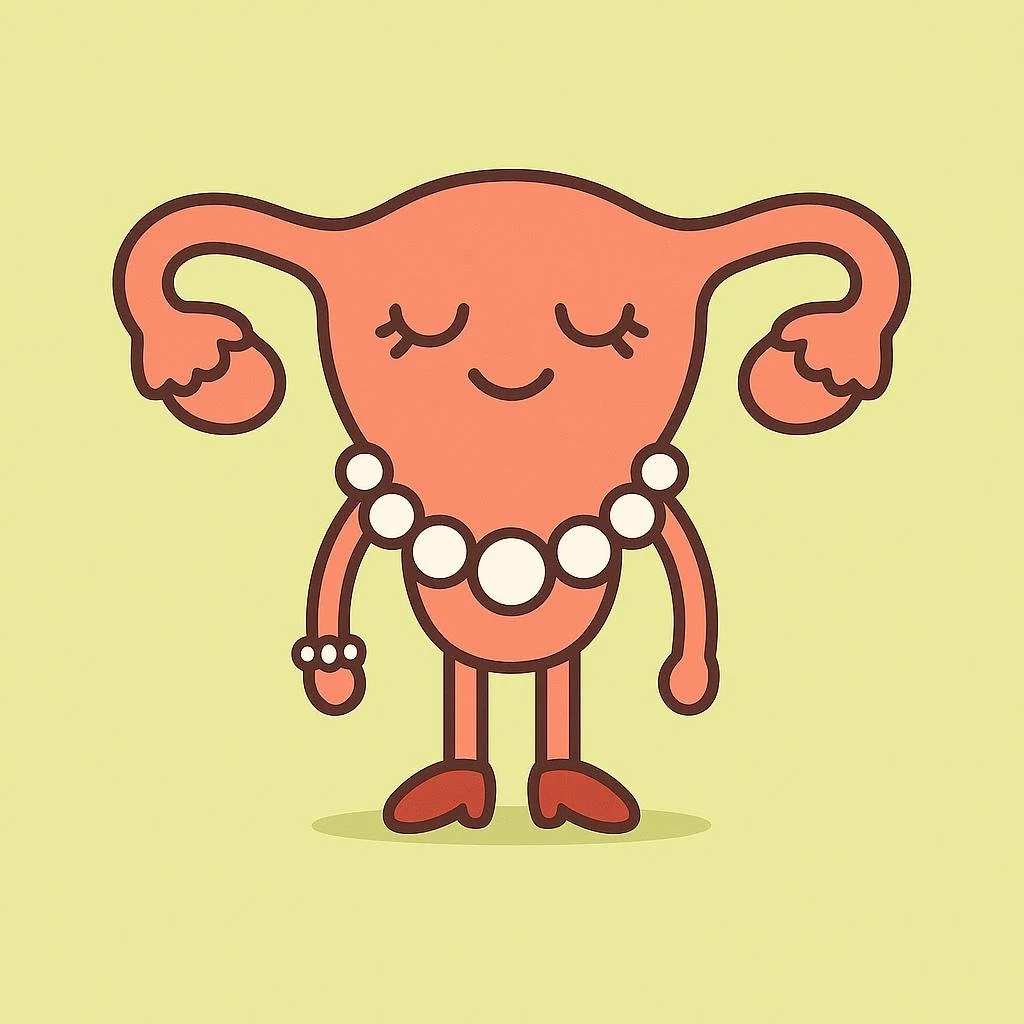Fibroids: What They Are and What to Do About Them
The uterus is a remarkable organ. It’s built to go from the size of a tennis ball to the size of a basketball in just nine months, growing and housing an entirely new human being along the way. That’s miraculous. No other organ in the body can expand, contract, and regenerate quite like it.
But with that much power comes a lot of responsibility, and a few design flaws. Complex systems are prone to glitches, and fibroids are one of them. Think of them as a glitch in the uterine code: a spot where the muscle tissue gets a little too enthusiastic and starts multiplying in one area, forming a firm, rubbery ball inside or on the uterus. They’re extremely common, usually benign (non-cancerous), and vary widely in size and effect. Let’s break down what they are, why they show up, and what to do about them.
What Exactly Are Fibroids?
Fibroids (medically called leiomyomas or myomas) are non-cancerous growths in the uterus. They’re made up of smooth muscle fibers and connective tissue (mostly collagen). They can appear as a single bump or as a cluster of growths scattered throughout.
They vary in size from tiny seedlings barely visible to the eye to large masses that can make the uterus look several months pregnant.
Fibroids are often described by their location:
- Submucosal fibroids grow into the uterine cavity (the endometrium, or lining — the part that sheds during your period).
- Intramural fibroids stay within the wall of the uterus (this is the muscle layer of the uterus).
- Subserosal fibroids project outward from the outside surface.
While there are cancerous fibroids (such as leiomyosarcomas), they are very rare compared to other reproductive cancers like breast, ovarian, or endometrial cancer. In the grand scheme of things, the vast majority of fibroids are benign.
What Causes Them (and Who Gets Them?)
There’s no single cause, but several factors can make fibroids more likely:
- Hormones: Estrogen and progesterone stimulate fibroid growth, which is why they tend to enlarge during reproductive years and shrink after menopause.
- Genetics: If your mom, sister, or aunt had fibroids, you’re at higher risk.
- Race: Fibroids are more common and often more severe in Black women, though women of all races can get them.
- Age: Most are diagnosed in the 30s and 40s, but they can appear earlier. After menopause, they usually shrink. New growths after menopause should always be evaluated by a doctor.
- Other factors: Early first period, obesity, diets high in red meat, and low vitamin D levels are all linked to higher risk.
Fibroids are incredibly common. By menopause, up to 70–80% of women will have them to some degree.
What are the Symptoms?
Fibroids are like real estate — it’s all about location, size, and number.
Where they grow and how big they get determines whether they cause problems, and what kind.
- Fibroids inside the cavity (submucosal) tend to cause heavy or prolonged periods.
- Fibroids in the wall (intramural) can cause cramping, pressure, or pelvic pain.
- Fibroids on the outside (subserosal) often cause bloating or pressure on other organs — like the bladder, leading to frequent urination, or the bowels, leading to constipation.
Other possible symptoms include:
- Heavy or prolonged bleeding
- Pelvic pressure or fullness
- Visible or bloated abdomen
- Pain during sex
- Constipation or back pain
- Fertility issues or pregnancy complications (depending on location)
And sometimes? None of the above. Many people have fibroids and never know it.
How They’re Diagnosed
Your provider might first feel an enlarged or irregular uterus during a pelvic exam, but imaging is what confirms fibroids.
- Ultrasound (transvaginal or pelvic): The go-to test for finding fibroids and checking their size, number, and location.
- MRI: Used when the ultrasound isn’t clear or to map fibroids before treatment.
- Other imaging: Fibroids sometimes show up incidentally on CT or other scans, but ultrasound or MRI is still needed to investigate further.
Treatment Options
Not every fibroid needs treatment. It depends on your symptoms, fibroid size and growth, and whether you want future pregnancies.
Watchful Waiting:
If your fibroids are small and symptom-free, no action may be needed.
Just keep track of bleeding, pressure, or pain, and have periodic imaging to monitor for changes. If symptoms develop or worsen, it’s time to re-evaluate.
Medications:
- Hormonal birth control (pill, patch, ring): These help control heavy bleeding and cramping but don’t shrink fibroids.
- Hormonal IUD (like Mirena): Excellent for reducing bleeding and pain.
- GnRH agonists and antagonists (like Lupron, Orilissa, Myfembree, or Oriahnn): These medicines turn the ovaries off temporarily, causing a chemical menopause. Think of this as a reversible hibernation where the ovaries are sleeping and not producing estrogen. It does not harm the ovaries permanently or affect future fertility. During this time, fibroids shrink as their food supply is cut off.
- Non-hormonal medications:
- Tranexamic acid (Lysteda) — taken during periods to reduce bleeding.
- NSAIDs (like ibuprofen or indomethacin) — for pain and cramping.
Non-Surgical Procedures:
- Uterine Artery Embolization (UAE): Tiny particles are injected into the arteries supplying the uterus to block blood flow, cutting off the fibroids’ oxygen and nutrients so they gradually die and shrink over time.
- Radiofrequency Ablation (RFA): Uses heat to destroy fibroid tissue.
- Acessa is done laparoscopically (through small belly incisions).
- Sonata is done through the vagina and cervix.
Many women have gone on to have successful pregnancies after these procedures, but fertility data are still limited. These are generally not recommended for people actively planning pregnancy until more research is available.
Surgical Options:
- Myomectomy: Removes the fibroids but keeps the uterus. Can be done hysteroscopically (through the cervix), laparoscopically (through small abdominal incisions), or via open surgery, depending on fibroid size and location. Fibroids can come back later, so follow-up is important.
- Hysterectomy: Removes the uterus entirely — the only definitive cure for fibroids. No chance of recurrence, but no future pregnancies either.
Lifestyle and Holistic Approaches
Lifestyle alone won’t shrink fibroids, but it may help manage symptoms or prevent progression.
- Maintain a healthy weight.
- Eat more fruits, vegetables, and whole grains; cut back on red meat.
- Limit alcohol.
- Supplement your Vitamin D levels: low levels are linked to higher fibroid risk. Taking Vitamin D may help slow fibroid growth!
Think of these as supportive tools, not replacements for medical treatment.
Fertility and Pregnancy
Fibroids can affect fertility, but not always. Many people with fibroids conceive and carry healthy pregnancies.
If you’re planning a pregnancy and have fibroids, talk to your provider about how your individual fibroids may affect your ability to get or carry a pregnancy, and what — if anything — you need to do about them.
Emotional Impact
Fibroids can be exhausting physically and emotionally and may take a toll on your quality of life depending on the symptoms they cause. Find a provider who listens to you and offers options that fit your goals. The good news is that there are many effective treatments, and new ones are being developed all the time. Relief is possible.
The Bottom Line
Fibroids are common but not untreatable. Whether you watch and wait, manage symptoms, or choose a procedure, you don’t have to live in discomfort.
Your uterus has superpowers. Let’s make sure they’re working for you, not against you.
The post contains affiliate links (because we gotta pay the light bill). As an Amazon Associate, we earn from qualifying purchases at no extra cost to you - but don’t worry: we only recommend products we truly believe in. 
